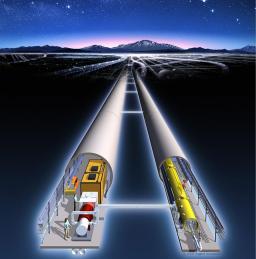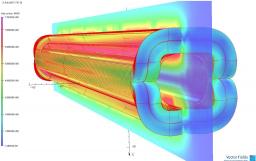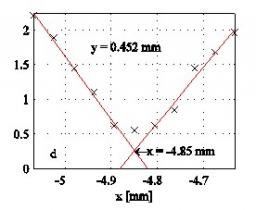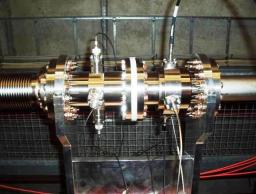ILC (International Linear Collider) is a project to build an electron-positron collider for particle physics research that attains energies on the order of a tera-electron volt. The participating laboratories decided to use high-gradient superconducting radiofrequency acceleration (25 MV/m and higher) in 2004, which was developed through the Tesla Collaboration and adjusted on the Flash accelerator (e.g. TTF) at the Desy laboratory (Deutsches elektronen synchrotron) in
ILC collider
The ILC project is based on linear accelerators with superconducting cavities made of solid niobium with accelerating fields of 31 MV/m or more. Attaining luminosities of 2x1034 cm-2s-1 requires beam sizes of 6 nm vertically at the collision point and power levels on the order of 11 MW per beam. The collisions involve roughly 3000 bunches per beam-pulse with a radiofrequency (RF) pulse of 1 ms. The RF pulse duration, enabled by superconducting technology, makes it possible to use a fast feedback method (3 MHz) to control the orbit of each bunch at the interaction point, thereby relieving the alignment and vibration tolerances of the accelerating and focalising elements.
As part of the international GDE (Global Design Effort) and the European EuroTeV project (Sixth Framework Programme for Research and Development, FP6), we are working on the design of high-energy beam focusing lines and on that of the interaction region. Three research themes are worth noting:
- Automatic optimisation of the final focus optical system, including local correction at the final doublet of chromatic aberrations.
- Study of collision stability for a zero-crossing angle in an interaction region including the large-aperture superconducting focusing magnets developed at SACM.
- Design and magnetic modelling of the solenoid for the LCD (Large Detector Concept) facilities being developed by European particle physics laboratories.
Flash, a superconducting linear accelerator
In addition to its 40 high-gradient superconducting accelerator cavities, with total energy on a giga-electron volt scale, the linear electron accelerator Flash enables developing instrumentation and beam diagnostics for the future XFEL and ILC facilities. SACM is involved in the facility's protection system, which uses fast electronics for comparing beam current measurements at various points along the linac. The department also sets up beam position monitors, which use two novel and complementary techniques:
- Reentry RF cavities adapted to the ultra-clean and cryogenic environmental of a Flash cryomodule and targeting micrometric resolution for control of the beam orbit in the quadruples.
- Use of high-order modes (HOM) in the accelerating cavities to improve cavity alignment relative to the beam and to minimise the effect of wake fields.
SACM also designed a cold RF tuning system for radiofrequency (1.3 GHz) in the accelerating cavities which includes a fast piezoelectric regulation system to compensate for radiation pressure forces. These developments were made possible by the financial support of the Care-SRF (Coordinated accelerator research in
• Accelerator physics and technology › Electron-positron linear accelerators
• Accelerators, Cryogenics and Magnetism Division (DACM)
• LEDA • pas de titre





